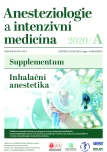Inhalational anesthetics in current anesthetic practice
Authors:
T. Gabrhelík 1; K. Nekvindová 1
Authors‘ workplace:
Oddělení anesteziologie, resuscitace a intenzivní medicíny, Krajská nemocnice Tomáše Bati, a. s., Zlín
1
Published in:
Anest. intenziv. Med., 31, 2020, č. Supplementum A, s. 17-21
Overview
Inhalational anesthetics are used for induction and maintenance of general anesthesia in the operating room. The volatile anesthetics (halothan, isoflurane, desflurane, and sevoflurane) are liquids and nitrous oxide is gas under normal temperature and pressure. All inhalational anesthetics provide dose-dependent amnesia and immobility, except for nitrous oxide, which also provides analgesia. This review article brings information about effects on organs, clinical use of the currently used anesthetics, their advantages and limitations.
Keywords:
inhalational anesthetics – nitrous oxide – isoflurane – sevoflurane – desflurane
Sources
1. Covarrubias M, Barber AF, Carnevale V, Treptow W, Eckenhoff RG. Mechanistic Insights into the Modulation of Voltage-Gated Ion Channels by Inhalational Anesthetics. Biophys J. 2015;109(10):2003-2011. doi: 10.1016/j.bpj.2015.09.032.
2. Matchett GA, Allard MW, Martin RD, Zhang JH. Neuroprotective effect of volatile anesthetic agents: molecular mechanisms. Neurol.Res. 2009;31(2):128-134.
3. Cahalan MK. Inhalační anestetika. In: Barash PG, Cullen BF, Stoelting RK, Cahalan MK, Stock MCh. Klinická anesteziologie. 1. vyd.. Praha: Grada 2015, p.165-166.
4. Uhlig CH, Bluth T, Schwarz K, Deckert S, Heinrich L, De Hert S., et al. Effects of Volatile Anesthetics on Mortality and Postoperative Pulmonary and Other Complications in Patients Undergoing Surgery: A Systematic Review and Meta-analysis. Anesthesiology. 2016;124 : 1230–1245.
5. Fukazawa K, Lee HT. Volatile Anesthetics and AKI: Risks, Mechanisms, and a Potential Therapeutic Window. JASN 2014;25(5): 884-892. doi: https://doi. org/10.1681/ASN.2013111215.
6. Fernandéz-Guisasola J, Gómez-Arnau JI, Cabrera Y, García del Valle S. Asosciation between nitrous oxide and the incidence of postoperative nausea and vomiting in adults, a systematic review and meta-analysis. Anaesthesia. 2010;65(4):379-387.
7. Hooijmans CR, Geessink FJ, Ritskes-Hoitinga M, Scheffer GJ. A Systematic Review of the Modifying Effect of Anaesthetic Drugs on Metastasis in Animal Models for Cancer. PLoS ONE 2016;11(5): e0156152. doi: https://doi.org/10.1371/journal.pone.0156152.
8. Husum B, Stenqvist O, Alahuhta S, Sigurdsson GH, Dále O. Current us of nitrous oxide in public hospitals in Scandinavian countries. Acta Anaesthesiol Scand 2013; 57(9):1131-1137.
9. Peyton PJ, Wu CY. Nitrous oxide-related postoperative nausea and vomiting depends on duration of exposure. Anesthesiology. 2014;120(5):1137-1145.
10. European Society of Anaesthesiology task force on the use of nitrous oxide in clinical anaesthetic practise. The current place of nitrous oxide in clinical practice: An expert opinion-based task force consensus statement of the European Society of Anaesthesiology. Eur J Anaesthesiol. 2015;32(8):517-520. doi: 10.1097/EJA.0000000000000264.
11. Thota RS, Ramkiran S, Garg R, Goswami J, Baxi V, Thomas M. Opioid free onco-anesthesia: Is it time to convict opioids? A systematic review of literature. J Anaesthesiol Clin Pharmacol. 2019;35 : 441-452.
12. Myles PS, Leslie K, Chan MTV, Forbes A, Peyton PJ, Paech MJ, et al., ANZCA Trials Group for the ENIGMA-II investigators. The safety of addition of nitrous oxide to general anaesthesia in at-risk patienst having major non-cardiac surgery (ENIGMA-II): a randomised, single-blind trial. Lancet 2014;384(9952):1446-1454.
13. Buhre W, Disma N, Hendrickx J, DeHert S, Hollmann MW, Huhn R, et al. European Society of Anaesthesiology Task Force on Nitrous Oxide: a narrative review of its role in clinical practice. Br J Anaesth. 2019;122(5):587-604.
14. Olutoye OA, Sheikh F, Zamora IJ, Yu L, Akinkuotu AC, Adesina AM. Repeated isoflurane exposure and neuroapoptosis in the midgestation fetal sheep brain. Am J Obstet Gynecol. 2016;214(4):542. doi: 10.1016/j.ajog.2015.10.927.
15. Sun L Early childhood general anaesthesia exposure and neurocognitive development. Br J 2010; 105(Suppl 1): i61-i68. doi:10.1093/bja/aeq302.
16. McCann ME, de Graaff JC, Dorris L, Disma N, Withington D, Bell G, et al., GAS Consortium: Neurodevelopmental outcome at 5 years of age after general anaesthesia or awake-regional anaesthesia in infancy (GAS): An international, multicentre, randomised, controlled equivalence trial. Lancet 2019;393 : 664 - 677.
17. Sun LS, Li G, Miller TL, Salorio C, Byrne MW, Bellinger DC, et al. Association between a single general anesthesia exposure before age 36 months and neurocognitive outcomes in later childhood. JAMA 2016;315 : 2312-2320.
18. Warner DO, Zaccariello MJ, Katusic SK, Schroeder DR, Hanson AC, Schulte PJ, et al. Neuropsychological and behavioral outcomes after exposure of young children to procedures requiring general anesthesia: The Mayo Anesthesia Safety in Kids (MASK) Study. Anesthesiology 2018;129 : 89-105.
19. Sio CLO, dela Cruz RGC, Bautista AF. Sevoflurane and renal function: a meta-analysis of randomized trials. Med Gas Res. 2017;7(3):186–193. doi: 10.4103/2045-9912.215748.
20. Vollmer MK, Rhee TS, Rigby M, Hofstetter D, Hill M, Schoenenberger F., et al. Modern inhalation anesthetics: Potent greenhouse gases in the global atmosphere. Geophysical Research Letters. 2015;42(5):1606 - 1611. doi: https://doi.org/10.1002/2014GL062785.
21. Macario A, Dexter F, Lubarsky D. Meta-analysis of trials comparing postoperative recovery after anesthesia with sevoflurane or desflurane. Am J Health Syst Pharm. 2005;62(1):63-68.
22. Chen G, Zhou Y, Shi Q, Zhou H. Comparison of early recovery and cognitive function after desflurane and sevoflurane anaesthesia in elderly patients: a meta-analysis of randomized controlled trials. J Int Med Res. 2015;43(5):619–628. doi: 10.1177/0300060515591064.
23. Dayan AD. Analgesic use of inhaled methoxyflurane: Evaluation of its potential nephrotoxicity. Hum Exp Toxicol. 2016;35 : 91–100.
24. Schraag S, Pradelli L, Alsaleh AJO, Bellone M, Ghetti G, Chung TL, et al. Propofol vs. inhalational agents to maintain general anaesthesia in ambulatory and in-patient surgery: a systematic review and meta-analysis. BMC Anesthesiol 2018;18:online. doi: https://doi.org/10.1186/s12871-018-0632-3.
25. Miller D, Lewis SR, Pritchard MW, Schofield-Robinson OJ, Shelton CL, Alderson P, et al. Intravenous versus inhalational maintenance of anaesthesia for postoperative cognitive outcomes in elderly people undergoing non‐cardiac surgery. Cochrane Database Syst Rev. 2018; 2018(8): CD012317. doi: 10.1002/14651858. CD012317.pub2.
Labels
Anaesthesiology, Resuscitation and Inten Intensive Care MedicineArticle was published in
Anaesthesiology and Intensive Care Medicine

2020 Issue Supplementum A
Most read in this issue
- Inhalational anesthetics in current anesthetic practice
- How to administer inhaled anesthetics correctly
- Desfluran
- Sevofluran
